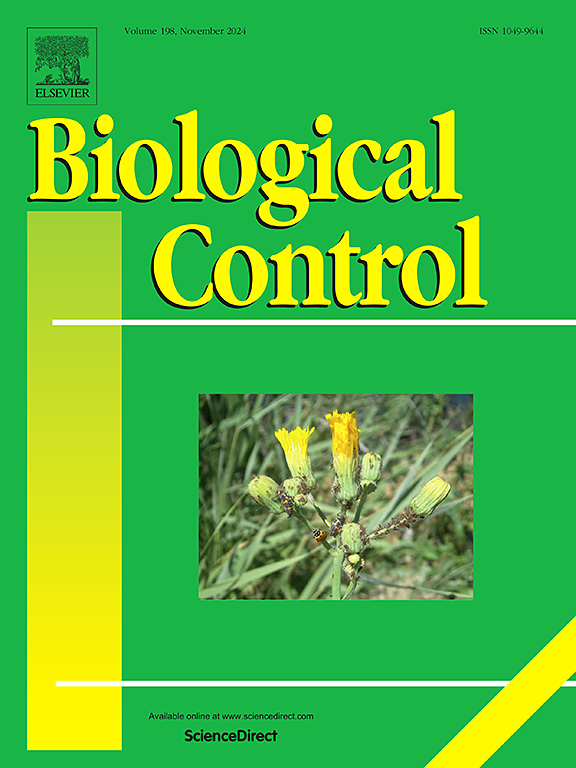Critical nymphal stages of Orius laevigatus for suboptimal feeding with pollen: Regulated deficit feeding
IF 3.4
2区 农林科学
Q2 BIOTECHNOLOGY & APPLIED MICROBIOLOGY
引用次数: 0
Abstract
Augmentative biological control has proven to be highly effective in numerous greenhouse crops, largely due to the use of omnivorous predators. Orius laevigatus (Fieber) is a key natural enemy against thrips, and for practical application, this predator is mass-reared in biofactories, where the optimal artificial diet consists of Ephestia kuehniella eggs, a costly resource. However, Orius is known to complete its development on pollen, although the quality of the individuals produced is generally lower. This led us to question whether there are less critical developmental stages which feeding could be reduced without negatively impacting performance, naming it as “regulated deficit feeding”. To test this, we examined how partially substituting Ephestia eggs with pollen at specific developmental stages would affect insect development and rearing cost. Additionally, we investigated whether supplementing suboptimal amounts of Ephestia eggs with pollen throughout the entire nymphal period could improve overall development. Moreover, we carried out this study comparing two standard commercial populations of O. laevigatus with two genetically improved strains for better performance feeding on pollen. Two periods were established for nymphal development: from N1 to N3 and from N4 to N5. The period from N1 to N3 was the most critical for suboptimal feeding, leading to reduced survival, body size and female fecundity. Feeding with Ephestia eggs in this critical period (N1-N3) but with pollen in the less critical (N4-N5) reduced the cost of rearing to 30–70% of that of the optimal diet, without impacting biological parameters except body size, especially in the artificially selected populations.

对花粉的次优摄食的关键若虫阶段:调控的亏缺摄食
增强型生物防治已被证明在许多温室作物中非常有效,主要是由于使用杂食性捕食者。金翅蓟马(Fieber)是蓟马的主要天敌,在实际应用中,这种捕食者在生物工厂中大量饲养,其中最佳的人工饲料由昂贵的库氏Ephestia kuehniella卵组成。然而,众所周知,虽然所产生的个体质量一般较低,但它是在花粉上完成发育的。这使我们质疑是否存在不太关键的发育阶段,在不对性能产生负面影响的情况下减少摄食,并将其命名为“调节缺陷摄食”。为了验证这一点,我们研究了在特定发育阶段用花粉部分替代Ephestia卵对昆虫发育和饲养成本的影响。此外,我们还研究了在整个若虫期补充次优量的Ephestia花粉是否能改善其整体发育。此外,本研究还对两个标准商业种群与两个遗传改良品系进行了比较,以期获得更好的采食花粉性能。确定了N1 ~ N3和N4 ~ N5两个时期的若虫发育。从N1到N3是次优摄食的最关键时期,导致成活率、体型和雌性繁殖力下降。在这个关键时期(N1-N3)以Ephestia卵饲喂,而在较不关键时期(N4-N5)以花粉饲喂,使饲养成本降低到最佳饲料的30-70%,除体型外,对其他生物学参数没有影响,特别是在人工选择的群体中。
本文章由计算机程序翻译,如有差异,请以英文原文为准。
求助全文
约1分钟内获得全文
求助全文
来源期刊

Biological Control
生物-昆虫学
CiteScore
7.40
自引率
7.10%
发文量
220
审稿时长
63 days
期刊介绍:
Biological control is an environmentally sound and effective means of reducing or mitigating pests and pest effects through the use of natural enemies. The aim of Biological Control is to promote this science and technology through publication of original research articles and reviews of research and theory. The journal devotes a section to reports on biotechnologies dealing with the elucidation and use of genes or gene products for the enhancement of biological control agents.
The journal encompasses biological control of viral, microbial, nematode, insect, mite, weed, and vertebrate pests in agriculture, aquatic, forest, natural resource, stored product, and urban environments. Biological control of arthropod pests of human and domestic animals is also included. Ecological, molecular, and biotechnological approaches to the understanding of biological control are welcome.
 求助内容:
求助内容: 应助结果提醒方式:
应助结果提醒方式:


